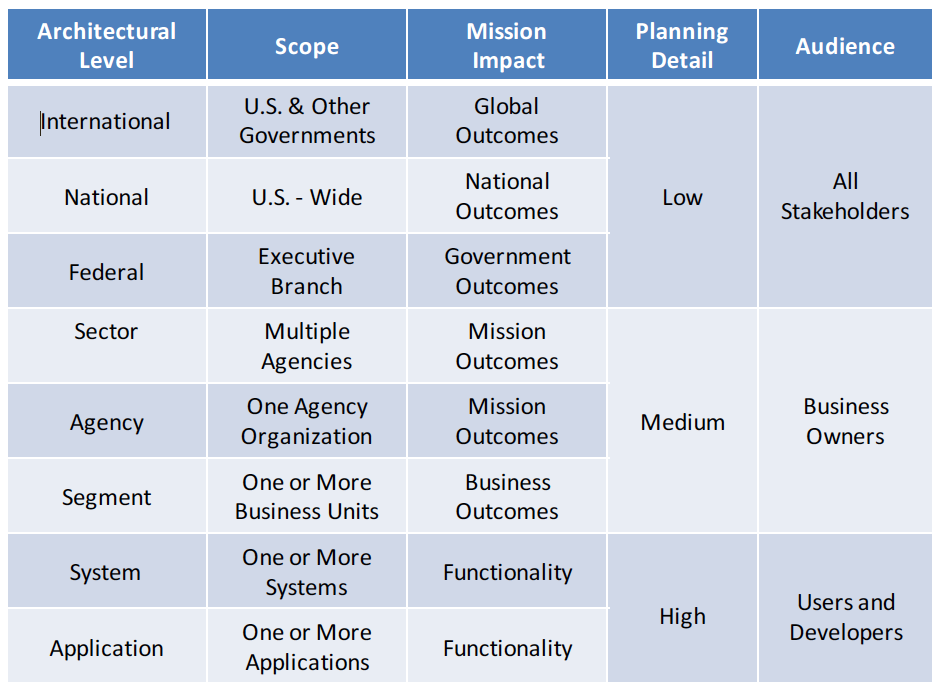 There are eight levels of scope for implementing an architecture using the common approach:
There are eight levels of scope for implementing an architecture using the common approach:
- International
- National
- Federal
- Sector
- Agency
- Segment
- System
- Application
These levels of scope promote consistency in architecture methods to promote comparability and support varying levels of complexity.
The scope of a particular architecture ranges from high level views of one or more organizations, to detailed views of a single segment, system, or application. Due to the nature of how the U.S. Federal Government functions, multiple levels of scope are needed to develop effective architectures that support mission and support objectives within and between agencies.
It should be noted that an enterprise-wide architecture for a Federal Agency will include strategic, business, and technology views that derive from documentation and analyses that are produced through architecture projects at the applicable levels of scope described herein. The standardized approach for federal agencies to use in creating and updating architectures involves a five-step method, design principles, and a set of core and elective artifacts in each of the six sub-architecture domains. These methods, principles, and artifacts are described in subsequent sections of this document.
Architecture at Various Levels of Scope
International: This level of architecture focuses on international partnerships of the U.S. Federal Government with other governments, global industry, non-profits, and other groups. These international-level architectures often center on the enablement of shared services, wherein the roles of provider and consumer need to be detailed and a comprehensive business model for the service provides the requirements for the architecture.
National: This level of architecture includes all Federal, State, Tribal, and Local government agencies within the U.S. and its territories. These architectures are very important to the coordination of nation-wide capabilities, such as first-responder coordination, disaster notification, telecommunications, and transportation infrastructure.
Federal: This level of architecture focuses on services (and associated systems) that serve the entire Executive Branch of the U.S. Federal Government. These Federal-wide mission and support services are channeled through OMB-designated “Line of Business” providers, wherein the roles of provider and consumer are detailed and a comprehensive business model for each Federal-wide service generate requirements for that architecture.
Sector: This level of architecture focuses on a system or service in one particular mission sector of the Executive Branch of the U.S. Federal Government. These inter-agency architectures often include the enablement of mission and/or support shared services, wherein the roles of provider and consumer need to be detailed and a comprehensive business model for the service provides the requirements for the architecture. These architectures may also include private sector participants.
Agency: This level of architecture provides an overview of the entire department/agency and consistent, decomposable views of all sub-agencies/bureaus, business units, programs, systems, networks, and mission or support services. The depth of documentation in any particular area of an agency’s architecture is determined by the need to support planning and decision-making, prioritized in the context of the agency’s strategic goals and business operating plans. Drill-down is accomplished through the completion of segment, system, and application-level architectures, as described below.
Segment: This level of architecture focuses on a particular service area or business unit within an agency or between agencies that is not Federal-, Sector-, or Agency-wide. Each segment is defined either organizationally (e.g., as a business unit and per the organization chart) or functionally (as a vertical or crosscutting mission or support service).
System: This level of architecture focuses on one particular information technology system, which supports the delivery of one or more services within or between segments and agencies. All aspects of a system’s functionality and configuration should be documented, including strategic drivers, business requirements, applicable standards, workflow processes, information exchanges, software applications, host infrastructure, remote access, and security/privacy controls.
Application: This level of architecture focuses on the development, update, or integration of one or more software applications that are part of one or more system(s)/service(s) in one or more organization(s). This includes websites, databases, email, and other mission or support applications.
Figure 2 shows the relationship between these levels of architectural scope, and the concept that the level of detail and scope for analysis and documentation will vary according to the requirements and planned usage for each architecture.
Figure 2. Levels of Architectural Scope and Impact
Content
